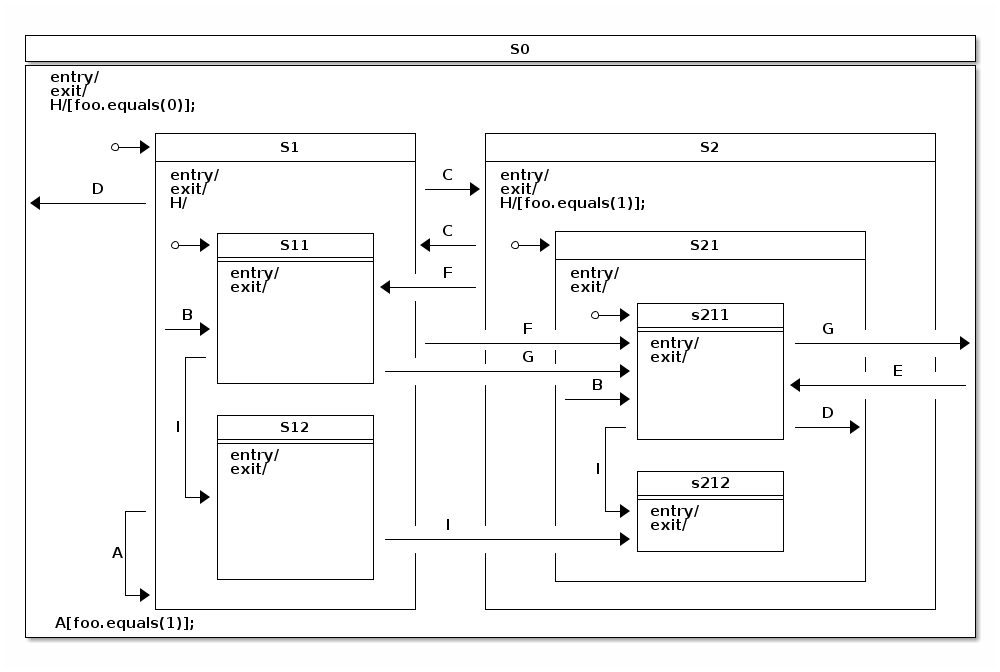Showcase is a complex state machine showing all possible transition topologies up to four levels of state nesting.

States.
public static enum States { S0, S1, S11, S12, S2, S21, S211, S212 }
Events.
public static enum Events { A, B, C, D, E, F, G, H, I }
Configuration - states.
@Override public void configure(StateMachineStateConfigurer<States, Events> states) throws Exception { states .withStates() .initial(States.S0, fooAction()) .state(States.S0) .and() .withStates() .parent(States.S0) .initial(States.S1) .state(States.S1) .and() .withStates() .parent(States.S1) .initial(States.S11) .state(States.S11) .state(States.S12) .and() .withStates() .parent(States.S0) .state(States.S2) .and() .withStates() .parent(States.S2) .initial(States.S21) .state(States.S21) .and() .withStates() .parent(States.S21) .initial(States.S211) .state(States.S211) .state(States.S212); }
Configuration - transitions.
@Override public void configure(StateMachineTransitionConfigurer<States, Events> transitions) throws Exception { transitions .withExternal() .source(States.S1).target(States.S1).event(Events.A) .guard(foo1Guard()) .and() .withExternal() .source(States.S1).target(States.S11).event(Events.B) .and() .withExternal() .source(States.S21).target(States.S211).event(Events.B) .and() .withExternal() .source(States.S1).target(States.S2).event(Events.C) .and() .withExternal() .source(States.S2).target(States.S1).event(Events.C) .and() .withExternal() .source(States.S1).target(States.S0).event(Events.D) .and() .withExternal() .source(States.S211).target(States.S21).event(Events.D) .and() .withExternal() .source(States.S0).target(States.S211).event(Events.E) .and() .withExternal() .source(States.S1).target(States.S211).event(Events.F) .and() .withExternal() .source(States.S2).target(States.S11).event(Events.F) .and() .withExternal() .source(States.S11).target(States.S211).event(Events.G) .and() .withExternal() .source(States.S211).target(States.S0).event(Events.G) .and() .withInternal() .source(States.S0).event(Events.H) .guard(foo0Guard()) .action(fooAction()) .and() .withInternal() .source(States.S2).event(Events.H) .guard(foo1Guard()) .action(fooAction()) .and() .withInternal() .source(States.S1).event(Events.H) .and() .withExternal() .source(States.S11).target(States.S12).event(Events.I) .and() .withExternal() .source(States.S211).target(States.S212).event(Events.I) .and() .withExternal() .source(States.S12).target(States.S212).event(Events.I); }
Configuration - actions and guard.
@Bean public FooGuard foo0Guard() { return new FooGuard(0); } @Bean public FooGuard foo1Guard() { return new FooGuard(1); } @Bean public FooAction fooAction() { return new FooAction(); }
Action.
private static class FooAction implements Action<States, Events> { @Override public void execute(StateContext<States, Events> context) { Map<Object, Object> variables = context.getExtendedState().getVariables(); Integer foo = context.getExtendedState().get("foo", Integer.class); if (foo == null) { log.info("Init foo to 0"); variables.put("foo", 0); } else if (foo == 0) { log.info("Switch foo to 1"); variables.put("foo", 1); } else if (foo == 1) { log.info("Switch foo to 0"); variables.put("foo", 0); } } }
Guard.
private static class FooGuard implements Guard<States, Events> { private final int match; public FooGuard(int match) { this.match = match; } @Override public boolean evaluate(StateContext<States, Events> context) { Object foo = context.getExtendedState().getVariables().get("foo"); return !(foo == null || !foo.equals(match)); } }
Lets go through what this state machine do when it’s executed and we send various event to it.
sm>sm start Entry state S0 Entry state S1 Entry state S11 Init foo to 0 State machine started sm>sm event A Event A send sm>sm event C Exit state S11 Exit state S1 Entry state S2 Entry state S21 Entry state S211 Event C send sm>sm event H Switch foo to 1 Event H send sm>sm event C Exit state S211 Exit state S21 Exit state S2 Entry state S1 Entry state S11 Event C send sm>sm event A Exit state S11 Exit state S1 Entry state S1 Entry state S11 Event A send
What happens in above sample:
-
State machine is started which takes it to its initial state S11
via superstates S1 and S0. Also extended state variable
foois init to0. -
We try to execute self transition in state S1 with event A but
nothing happens because transition is guarded by variable
footo be1. -
We send event C which takes us to other state machine where
initial state S211 and its superstates are entered. In there we
can use event H which does a simple internal transition to flip
variable
foo. Then we simply go back using event C. - Event A is sent again and now S1 does a self transition because guard evaluates true.
-
It’s also worth to pay attention to how event H is handled in
different states S0, S1 and S2. This is a good example of how
hierarchical states and their event handling works. If state S2 is
unable to handle event H due to guard condition, its parent is
checked next. This guarantees that while on state S2,
fooflag is always flipped around. However in state S1 event H always match to its dummy transition without guard or action, not never happens.